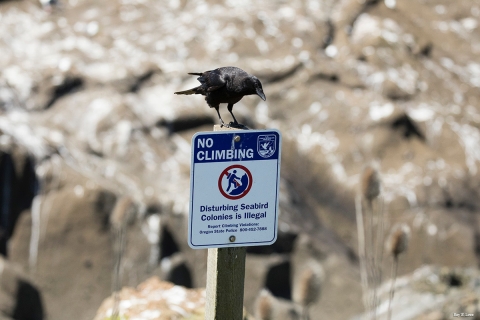Facility Rules and Policies
The partnership at Cape Meares between the U.S. Fish and Wildlife Service and Oregon Parks and Recreation Department benefits both wildlife and people. Cape Meares is a National Wildlife Refuge adjacent to a State Park, so wildlife will always find sanctuary here, and people will always have the opportunity to observe it.
Rules and Policies of the National Wildlife Refuge and State Scenic Viewpoint may differ: visit the Cape Meares State Scenic Viewpoint website for more information.
Dogs on a short leash are allowed at this State Park and National Wildlife Refuge.
Enjoy the Refuge from designated trails and leave the rest of the Refuge for wildlife.
It is illegal to operate unmanned aircraft from Refuge lands. Special Use Permits are issued when drone use is deemed appropriate. National Wildlife Refuge System lands are often home to threatened and endangered species—these wildlife can be disproportionately affected by drone flights. Disturbing wildlife is illegal. Fines can be levied if a drone is observed disturbing wildlife, e.g. flushing nesting birds from an offshore island or causing resting seals or sea lions to flee for the water, regardless of where the operator is standing. For more information on drone use over refuges, consult the Service's UAS Resource Guide. Get a detailed guide to responsible drone use here.
Keep your distance from wildlife resting on rocks and beaches. All migratory birds are protected under the Migratory Bird Treaty Act, which applies to all seabirds, and all Marine Mammals are protected under the Marine Mammal Protection Act (MMPA). These Acts forbid the harassment of these animals, which includes disturbance of any kind. The MMPA advises beachgoers to stay at least 50 yards away from marine mammals. A good rule of thumb is: if the animal reacts to your presence or activities, you are too close! For a surefire way to observe wildlife without undue disturbance, bring binoculars, a spotting scope, or camera.
Hunting is not permitted at this refuge.
Playing recorded bird calls to entice or elicit a response from birds in the wild is discouraged. We discourage the use of recordings, apps, or websites for the purpose of eliciting a response in wildlife because it can be disturbing to wildlife and other visitors. Two Refuge regulations apply: 50 CFR 27.51 prohibits disturbing and attempting to disturb wildlife on any National Wildlife Refuge and 50 CFR 27.72 prohibits “the operation or use of audio devices including radios, recording and playback devices, loudspeakers....so as to cause unreasonable disturbance to others in the vicinity.” Use of audio devices to lure birds violates both regulations.
Anywhere you visit the outdoors, help preserve the beauty of nature. Take only pictures and leave only footprints. Learn more about Leave No Trace.
The unauthorized operation of aircraft or aerial devices, including sail planes, kites, hang gliders, or other activities at altitudes resulting in harassment of wildlife, or the unauthorized take-off or landing on a National Wildlife Refuge, except in an emergency, is prohibited. National Wildlife Refuge boundaries are designated on up-to-date FAA aeronautical charts. Seabirds and Marine Mammals are protected under multiple federal acts and disturbing them is illegal. A good rule of thumb is: if the animal reacts to your activities, you are too close!
All 1,854 rocks, reefs and islands of Oregon Islands National Wildlife Refuge and nine rocks and islands of Three Arch Rocks National Wildlife Refuge are closed to the public at all times. These National Wildlife Refuges are maintained for the protection of wildlife. People are not permitted to climb, scramble, or access rocks, sea stacks or islands. Doing so may disturb wildlife and harm habitat.
In addition to being sanctuary for wildlife, these lands are designated National Wilderness Areas: “where the earth and its community of life are untrammeled by man, where man himself is a visitor who does not remain.” These areas enjoy the most stringent restrictions of all federal lands in the U.S., managed to preserve Wilderness characteristics. Learn more about National Wilderness Preservation System.
No collecting of any natural materials such as mushrooms, invertebrates, rocks, shells, berries, etc. Because these items are important sources of nutrients and habitat to various animals, the Fish and Wildlife Service authorizes their collection only by special permit. Code of Federal Regulations Title 50 Part 27 Section 61 (50 CFR 27.61) prohibits the unauthorized removal of any public property, including natural objects from any National Wildlife Refuge. Enjoy viewing plants, animals, and natural materials where you find them.
Physical geocaches are not permitted on National Wildlife Refuges, though virtual geocaching is permitted. Traditional geocaching requires the burial of materials or placement of an item in a location, which requires compatibility with refuge purposes and a Special Use Permit. To learn more about this distinction contact the Refuge.
The refuge is open sunrise to sunset. Unauthorized overnight parking and camping are strictly prohibited at this National Wildlife Refuge. Violation of these rules may result in a fine.
Only the following persons may possess, use, or transport firearms on National Wildlife Refuges in accordance with this section and applicable Federal and State law: (a) Persons using firearms for public hunting under the provisions of 50 CFR part 32. (b) Persons carrying unloaded firearms, that are dismantled or cased, in vehicles and boats over routes of travel designated under the provision of subchapter C. (c) Persons authorized to use firearms for the taking of specimens of wildlife for scientific purposes. (d) Persons authorized by special regulations or permits to possess or use firearms for the protection of property, for field trials, and other special purposes. [46 FR 47230, Sept. 25, 1981]
Bicycle use is permitted on roads leading to refuge parking areas, and bikes may be locked at racks located within parking areas. Biking is not permitted on trails due to the narrow walkways, the presence of pedestrians, and the resulting potential for user conflicts. Trails are limited to pedestrian and disabled-access users.


